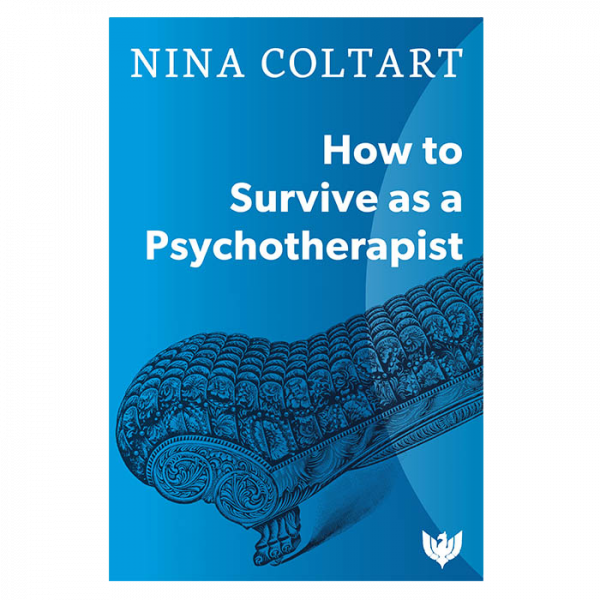On the Great Nina Coltart
Foolishly, however, at one point I gave the book away, and have ever after regretted it. But now Phoenix Books has done us all the huge favour of bringing out all three of Coltart's books once again so that, as they say, a new generation can appreciate her. Their lists are some of the most interesting today in psychotherapy, psychoanalysis, and related fields, and that website is one every clinician, and those interested in the psychotherapeutic arts diversely understood, should keep close eye on. Phoenix kindly sent me a fresh copy of Slouching to allow me to read it again and post some thoughts about it.
If, like me, you prefer to know a bit about an author before reading, then the short bio on the Phoenix website gives you some of Coltart's details.
If, probably unlike me, you grow a bit obsessive about authors you love, and you really want to know rather more about Coltart, then permit me to point you in the direction of a charming if posthumously published Festschrift for her, Her Hour Come Round at Last: A Garland for Nina Coltart, eds. Gillian Preston and Peter L. Rudnytsky (Routledge, 2011). Fascinatingly, that collection contains essays from some of Coltart's former patients as well as colleagues and friends. It also contains some unpublished material that is lovely to read. The whole book is a garland of riches indeed.
But back to Coltart and her Slouching towards Bethlehem, and a final bit of prolegomena: don't just take my word--that of a nobody teaching in the remoter parts of obscure provinces of the American imperium--for Coltart's virtues. No less a figure than the great Adam Phillips reviewed her book very favourably in the London Review of Books, which you may find here.
On Attention:
Right, down to business. Given where my previous entry on here ended, with an express desire to think more about how therapists train and exercise their attention and presence within a session, I began with Coltart's very last chapter entitled, quite simply, "Attention." (In the book, which is really a collection of essays, this chapter is linked thematically with the one immediately before it, "The Practice of Psychoanalysis and Buddhism." That is true of all the chapters--there is a thread that links at least two or three of them clearly, but all of them indirectly, making this a very coherent and cohesive collection.) I then proceeded to read the book backwards. I will comment on some but not all of the book's 12 chapters, leaving the rest for you to discover.
This last chapter, originally written sometime around 1989-90, begins by noting that the topic of attention was then almost completely ignored in the clinical literature despite how central a part of therapeutic practice it has always been. Here in this chapter--and elsewhere--Coltart says that "I believe being a good therapist is a vocation" and shortly afterwards speaks of "psychiatric monks" as well. Though Coltart has a different type of monk in mind (Buddhist, rather than Christian, as the preceding chapter and other writings make clear), both phrases resonate with me today much more than they would have when I first read the book, for, as I suggested last year at this time, following the lead of the eminent historian Peter Brown, the monastic "disclosure of thoughts" pioneered by Evagrius of Pontus in the Upper Egyptian desert of the fourth century was psychoanalytic avant la lettre, and still reminds me that psychotherapy is indeed in some ways monastic--in the sense of being hidden, but also of being focused on one thing only, viz., the welfare and flourishing of your patient.
To be so focused, Coltart continues, requires a "profound and self-forgetful opening of oneself to another person" (185). This is what she speaks of as "bare attention,"
To allow the beeps of our phones, and texts, and Tweets, to at all interrupt a session with a patient is the sort of thing that would have filled Coltart with horror, regarding it as simply bad manners among other things. At the very least, paying attention--deep, close, self-forgetful attention--to another person in one's consulting room is, if nothing else, simply an extension of basic good, gracious manners. In her meandering style, Coltart reflects on manners as an often middle-class obsession, and what that might conceal, and how in some people (she specifically references the perhaps now-extinct character of a minor aristocrat running some British colonial outpost) manners function as a hard shell preventing them from accessing any depth in either themselves or others.
She resumes her discussion of attention in this chapter, saying that showing basic courtesies to one's patients and colleagues is one of those things, like attention, that we take for granted and is under-theorized but nonetheless crucial: "The capacity to be attentive in all its essential modes is a highly disciplined and hard-earned skill. We need to pay constant attention to attention, its uses, its value, and our power to sharpen it up and refine it" (143).
We--both patient and therapist--can be paying attention even in silence. Her chapter "The Silent Patient" is one that I strongly gravitate towards, in part because my experience of silence in analysis was, and remains, perhaps its most lasting gift to me. The idea that one was not expected to produce anything took me a long time to adjust to. I was (and remain) a prolific dreamer during analysis and felt daily offerings of dreams were proof of being a good patient. Only much later did I realize I didn't have to do any of this, and so could spend some days on the couch not producing or saying much of anything.
Silence, in Coltart's experience, is rather different and she is not at all inclined to idealize it. She had several patients who were deeply silent for at least several weeks, and some several months, and one for longer still. By "silent" she says someone who speaks less than 10% of the time. In all her cases, it was not so much that patients were leisurely experiencing silence as a welcome respite so much as using it for a variety of reasons, some of them sadistic, others reflecting early trauma, all of them quite serious.
This chapter, and the very first one in the book, give us the most "infamous" case Coltart ever wrote about: the one where she bawled out a silent patient for his sadistic attack on the work ("attacks on linking" indeed!), an intervention she only used once but it had the intended effect of rescuing the treatment from collapse. (My description is making it sound lurid and will not do justice to it: you must read it yourself.) This chapter is also valuable for its reflections on the role that humour can play in therapy. Though she does not say so explicitly here, we know from other writings (see below) that she very much agreed with Winnicott that one should be able to enjoy one's patients and the work with them. If you only see it as a slog, you'll not last long as a therapist.
On Love:
To offer attention, and to sit through periods of silence, is to offer love in several ways. Enjoyment, it seems to me, is related here to her reflections on love. This is not nearly so radical as is thought, for Freud himself (in his correspondence with Jung, and in discussions in the Vienna Society before their schism) talked about the role of love in therapy and not merely as "transference love," either. Rather, he said quite rightly that "our cures are the cures of love."
Coltart very much agrees with Freud on this, but goes beyond him to argue that in fact--all his protestations notwithstanding--there is a moral core and vision at the heart of psychoanalysis and it is best to be clear about this. (I think Coltart indisputably right on this, but as MacIntyre showed us forty years ago now, it is the hallmark of intellectuals to acclaim their own blindness, above all about "morality.") In arguing this, she draws on some of the leading lights of the British Independent tradition, including Neville Symington, Christopher Bollas, Michael Balint, and Winnicott.
Some Maxims:
Verbal Minimalism: A few maxims from different parts of the book reinforce what I've heard from two excellent supervisors: "When in doubt, say nothing." (This, of course, admits of wide application outside one's consulting room.) Two others reinforce this asceticism of speech, as it were: "Prune where you can." And then, if you find yourself going "On the one hand.....but on the other," Coltart bluntly says stop.
Don't assume too much power to any one thing you say. Coltart reports how often something she thought brilliant or disastrous had little long-term effect on the patient and, with equal surprise, how often patients, years later after treatment, may send a note or see her on the street and say "I've never forgotten when you said X," and report something the therapist has either forgotten or, worse, thought feeble or rubbish at the time.
Harnessing Your Aggression: As we saw in Michael Karson, who speaks of "virtuous aggression," so Coltart says a therapist should "harness our aggression skillfully in the service of clinical work and that so doing is a "strongly positive factor" which patients will welcome. But such skillful use requires work in and by the therapist on him/herself so that it is done without fear or anxiety.
Never Take Notes: At least never in the presence of the patient!
An Apologia:
From Slouching Towards Bethlehem in two separate places are cogent descriptions of how many difficult things the therapist must try to pull off at once, and in every session. These two passages seem to me to be the best apologias for what it is we try to do, and you should feel free to share these widely with your relations or friends or monstrous insurance companies who sneeringly "think" therapy is just two people having a (likely unnecessary) chat, much as one lazily wiles away an afternoon over a cup of coffee in a shop. Instead of that, Coltart says the therapist must be capable of a healthy kind of psychic split, enabling him or her to be capable of
sharply focusing, and scanning; complex involvement in feelings, and cool observation of them; close attention to the patient, and close attention to ourselves; distinguishing our own true feelings from subtle projections into us; communicating insight clearly, yet not imposing it; drawing constantly on resources of knowledge, yet being ready to know nothing for long periods; willing the best for our patients and ourselves, yet abandoning memory and desire; a kind of tolerant steadiness which holds us while we make innumerable, minute moral decisions, yet steering clear of being judgmental (119).
the need for consistent scanning and judging, not only of what the other person says, but of what we are about to say, and are saying; and with this scanning, the need for rapid continuous thinking, which may be only half-conscious; the need for repeated moral and technical decision-making; and yet if it is to convey truth, and more importantly, authenticity, in our style of speech we must also master intuitive, unlaboured spontaneity. This is an extremely demanding and complex requirement...[and]...it depends, for success...on...the combination of unselfconscious self-forgetfulness with deep self-confidence (145).
Final Thoughts:
I would, however, add to that that I now think--in ways I didn't in the early 90s--Coltart's other two books, both of them also helpfully brought back into print by Phoenix, are perhaps even more valuable. I wrote about both of them earlier this year here and here. Thanks to Phoenix, and if ordered directly from them, you can get all three new and at a very affordable rate.



Comments
Post a Comment